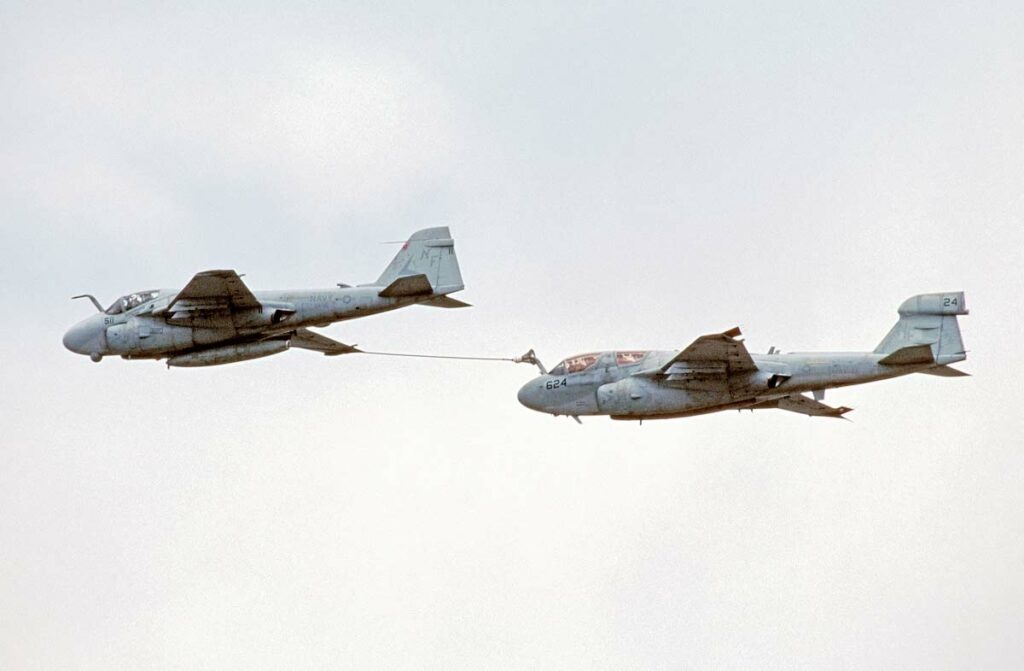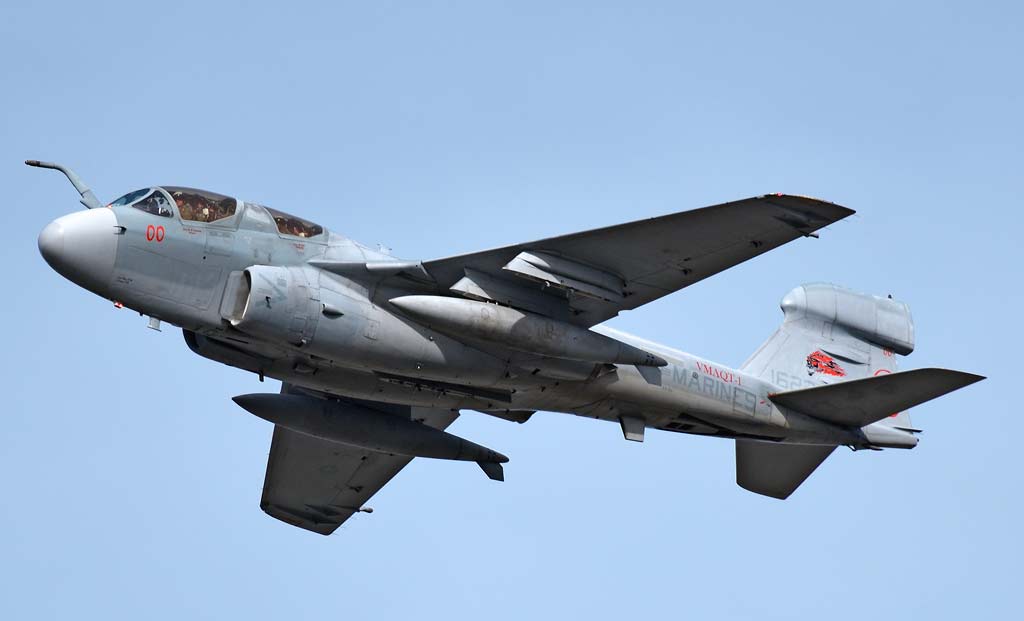The Grumman EA-6 Prowler: a premier electronic warfare aircraft, excelling in signal jamming, surveillance, and enemy defense suppression.
In Brief
The Grumman EA-6 Prowler was a cornerstone of American electronic warfare, serving from the Vietnam War era to the 21st century. This twin-engine, mid-wing aircraft was designed to provide electronic attack (EA) capability, including standoff jamming, electronic protection, and electronic attack. Equipped with the ALQ-99 tactical jamming system, it carried an extensive array of sensors and jamming equipment, enabling it to perform various roles such as signal intelligence gathering, airborne electronic jamming, and suppression of enemy air defenses (SEAD). The Prowler could carry AGM-88 HARM missiles to engage radar sites actively. Its capability to support air operations by degrading enemy electronic capabilities and gathering intelligence made it invaluable in modern warfare.

History of the Development of the Grumman EA-6 Prowler
The Grumman EA-6 Prowler’s inception was deeply rooted in the Cold War’s strategic complexities, where electronic warfare became increasingly paramount. Originating from the need for a sophisticated platform to conduct electronic warfare and radar jamming, the EA-6 was designed to protect strike aircraft, ground troops, and ships by interrupting enemy radar and communications. This requirement became crucial following experiences in the early Cold War period, highlighting the vulnerability of aircraft to advanced anti-aircraft defenses.
Developed by Grumman Aerospace, the Prowler was a derivative of the A-6 Intruder airframe, tailored to electronic warfare tasks. The project, initiated in the early 1960s, aimed to replace the aging Douglas EA-1F Skyraiders. The first EA-6 Prowler flew on May 25, 1968, embodying the culmination of extensive research and development focused on integrating advanced electronic warfare systems into a proven airframe.
The development of the EA-6 Prowler was a strategic move to enhance the U.S. Navy and Marine Corps’ capabilities in electronic warfare, ensuring air superiority through non-kinetic means. It was designed without a specific NATO nickname but was universally recognized for its unique role in electronic warfare, often being the linchpin in mission-critical scenarios where electronic surveillance and jamming were key to mission success.
Design of the Grumman EA-6 Prowler
The EA-6 Prowler was engineered to excel in electronic warfare, featuring a design that accommodated an extensive suite of sophisticated electronic jamming equipment. Its elongated fuselage housed four crew members – a pilot and three Electronic Countermeasures Officers (ECMOs) – responsible for operating its complex array of electronic warfare systems. The aircraft was equipped with the ALQ-99 tactical jamming system, capable of disrupting enemy radar and communications, thereby protecting friendly forces and assets.
Structurally, the Prowler shared the basic design and flight characteristics of the A-6 Intruder, including its twin-engine layout, which provided redundancy and reliability, crucial for its demanding missions. The airframe was modified to include a larger vertical tail and an extended aft section to accommodate additional equipment and fuel, enhancing its range and endurance.
The advantage of the Prowler’s design was its ability to carry a vast array of electronic equipment, enabling it to conduct a wide range of electronic warfare operations, from jamming to intelligence gathering. However, the complexity of its systems and the specialized nature of its mission meant that it required highly trained crews and extensive support, posing logistical and operational challenges.
Performance of the Grumman EA-6 Prowler
The EA-6 Prowler’s performance was optimized for electronic warfare rather than speed or agility. Powered by two Pratt & Whitney J52-P-408a engines, each providing up to 10,400 pounds of thrust, the aircraft had a maximum speed of 590 knots (678 mph, 1,092 km/h) and could operate at altitudes up to 37,600 feet (11,460 meters). Its range was significantly extended by its in-flight refueling capability, enabling it to loiter in mission areas as required.
While not designed for dogfighting or high-speed interception, the Prowler’s strength lay in its endurance, electronic warfare capabilities, and the ability to carry out missions in all weather conditions, day or night. Its operational effectiveness was demonstrated by its capacity to provide electronic protection for both airborne and ground units, significantly degrading the enemy’s ability to detect and engage friendly forces.
Variants of the Grumman EA-6 Prowler
The EA-6 Prowler variants mainly included the initial EA-6A and the more advanced EA-6B. The EA-6A was the initial version, used primarily by the U.S. Marine Corps for tactical electronic warfare. The EA-6B, introduced in 1971, was a significant upgrade, incorporating advanced electronic warfare systems and the capability to carry AGM-88 HARM missiles, making it a key asset in Suppression of Enemy Air Defenses (SEAD) missions.

Military Use and Combat of the Grumman EA-6 Prowler
The EA-6 Prowler was extensively used in various conflicts, providing electronic warfare support that was critical in ensuring the success of military operations. Its debut in combat was during the Vietnam War, where it quickly proved essential in jamming enemy radar and communications. Subsequently, it played a pivotal role in operations in Grenada, Libya, the Balkans, Iraq, Afghanistan, and Syria, adapting to the evolving electronic warfare landscape.
The Prowler’s ability to conduct SEAD missions, gather electronic intelligence, and provide a blanket of protection against enemy radar-guided weapons was unparalleled. It worked alongside aircraft like the F/A-18 Hornet, providing essential support that enabled successful air strikes and mission accomplishment in contested environments.
The aircraft was retired from active service in the U.S. Navy in 2015, replaced by the EA-18G Growler, which offered advanced electronic warfare capabilities in a more modern airframe. However, its legacy endures, with its contributions to electronic warfare and combat support remaining highly regarded.
The Grumman EA-6 Prowler stands as a testament to the critical importance of electronic warfare in modern combat. Its sophisticated jamming capabilities, combined with the dedicated expertise of its crews, made it an invaluable asset in protecting friendly forces and ensuring the success of countless missions across several decades. While now succeeded by newer platforms, the Prowler’s enduring legacy reflects its significant impact on the evolution of aerial electronic warfare and its pivotal role in shaping the outcome of modern aerial and ground combat operations.
Back to the Special Aircraft section